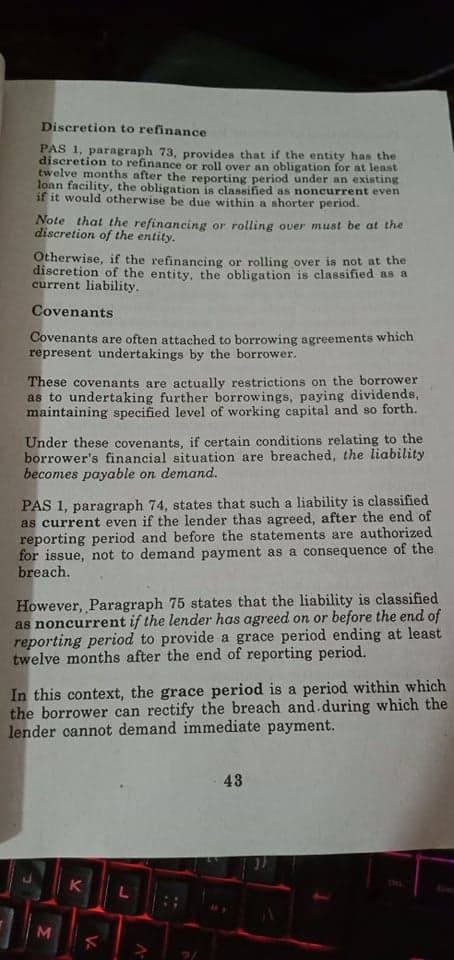TRUE OR FALSE? (Based on the book.) The effect of a lender agreeing to give the borrowing entity a grace period within the reporting period will make a liability noncurrent.
TRUE OR FALSE? (Based on the book.) The effect of a lender agreeing to give the borrowing entity a grace period within the reporting period will make a liability noncurrent.
Chapter1: Financial Statements And Business Decisions
Section: Chapter Questions
Problem 1Q
Related questions
Question
TRUE OR FALSE? (Based on the book.)
The effect of a lender agreeing to give the borrowing entity a grace period within the reporting period will make a liability noncurrent.

Transcribed Image Text:Discretion to refinance
PAS 1, paragraph 73, provides that if the entity has the
discretion to refinance or roll over an obligation for at least
twelve months after the reporting period under an existing
loan facility, the obligation is classifed as noncurrent even
if it would otherwise be due within a shorter period.
Note that the refinancing or rolling over must be at the
discretion of the entity.
Otherwise, if the refinancing or rolling over is not at the
discretion of the entity, the obligation is classified as a
current liability.
Covenants
Covenants are often attached to borrowing agreements which
represent undertakings by the borrower.
These covenants are actually restrictions on the borrower
as to undertaking further borrowings, paying dividends,
maintaining specified level of working capital and so forth.
Under these covenants, if certain conditions relating to the
borrower's financial situation are breached, the liability
becomes payable on demand.
PAS 1, paragraph 74, states that such a liability is classified
as current even if the lender thas agreed, after the end of
reporting period and before the statements are authorized
for issue, not to demand payment as a consequence of the
breach.
However, Paragraph 75 states that the liability is classified
as noncurrent if the lender has agreed on or before the end of
reporting period to provide a grace period ending at least
twelve months after the end of reporting period.
In this context, the grace period is a period within which
the borrower can rectify the breach and.during which the
lender cannot demand immediate payment.
43
K
M
Expert Solution
This question has been solved!
Explore an expertly crafted, step-by-step solution for a thorough understanding of key concepts.
Step by step
Solved in 2 steps

Knowledge Booster
Learn more about
Need a deep-dive on the concept behind this application? Look no further. Learn more about this topic, accounting and related others by exploring similar questions and additional content below.Recommended textbooks for you


Accounting
Accounting
ISBN:
9781337272094
Author:
WARREN, Carl S., Reeve, James M., Duchac, Jonathan E.
Publisher:
Cengage Learning,

Accounting Information Systems
Accounting
ISBN:
9781337619202
Author:
Hall, James A.
Publisher:
Cengage Learning,


Accounting
Accounting
ISBN:
9781337272094
Author:
WARREN, Carl S., Reeve, James M., Duchac, Jonathan E.
Publisher:
Cengage Learning,

Accounting Information Systems
Accounting
ISBN:
9781337619202
Author:
Hall, James A.
Publisher:
Cengage Learning,

Horngren's Cost Accounting: A Managerial Emphasis…
Accounting
ISBN:
9780134475585
Author:
Srikant M. Datar, Madhav V. Rajan
Publisher:
PEARSON

Intermediate Accounting
Accounting
ISBN:
9781259722660
Author:
J. David Spiceland, Mark W. Nelson, Wayne M Thomas
Publisher:
McGraw-Hill Education

Financial and Managerial Accounting
Accounting
ISBN:
9781259726705
Author:
John J Wild, Ken W. Shaw, Barbara Chiappetta Fundamental Accounting Principles
Publisher:
McGraw-Hill Education